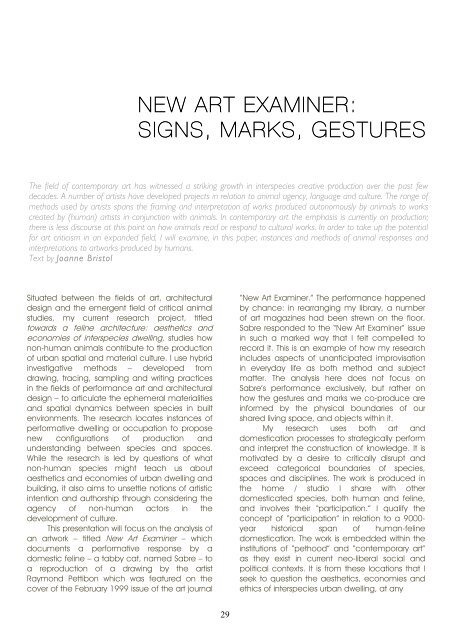Animal Influence I - Antennae The Journal of Nature in Visual Culture
Animal Influence I - Antennae The Journal of Nature in Visual Culture
Animal Influence I - Antennae The Journal of Nature in Visual Culture
Create successful ePaper yourself
Turn your PDF publications into a flip-book with our unique Google optimized e-Paper software.
Situated between the fields <strong>of</strong> art, architectural<br />
design and the emergent field <strong>of</strong> critical animal<br />
studies, my current research project, titled<br />
towards a fel<strong>in</strong>e architecture: aesthetics and<br />
economies <strong>of</strong> <strong>in</strong>terspecies dwell<strong>in</strong>g, studies how<br />
non-human animals contribute to the production<br />
<strong>of</strong> urban spatial and material culture. I use hybrid<br />
<strong>in</strong>vestigative methods – developed from<br />
draw<strong>in</strong>g, trac<strong>in</strong>g, sampl<strong>in</strong>g and writ<strong>in</strong>g practices<br />
<strong>in</strong> the fields <strong>of</strong> performance art and architectural<br />
design – to articulate the ephemeral materialities<br />
and spatial dynamics between species <strong>in</strong> built<br />
environments. <strong>The</strong> research locates <strong>in</strong>stances <strong>of</strong><br />
performative dwell<strong>in</strong>g or occupation to propose<br />
new configurations <strong>of</strong> production and<br />
understand<strong>in</strong>g between species and spaces.<br />
While the research is led by questions <strong>of</strong> what<br />
non-human species might teach us about<br />
aesthetics and economies <strong>of</strong> urban dwell<strong>in</strong>g and<br />
build<strong>in</strong>g, it also aims to unsettle notions <strong>of</strong> artistic<br />
<strong>in</strong>tention and authorship through consider<strong>in</strong>g the<br />
agency <strong>of</strong> non-human actors <strong>in</strong> the<br />
development <strong>of</strong> culture.<br />
This presentation will focus on the analysis <strong>of</strong><br />
an artwork – titled New Art Exam<strong>in</strong>er – which<br />
documents a performative response by a<br />
domestic fel<strong>in</strong>e – a tabby cat, named Sabre – to<br />
a reproduction <strong>of</strong> a draw<strong>in</strong>g by the artist<br />
Raymond Pettibon which was featured on the<br />
cover <strong>of</strong> the February 1999 issue <strong>of</strong> the art journal<br />
NEW ART EXAMINER:<br />
SIGNS, MARKS, GESTURES<br />
<strong>The</strong> field <strong>of</strong> contemporary art has witnessed a strik<strong>in</strong>g growth <strong>in</strong> <strong>in</strong>terspecies creative production over the past few<br />
decades. A number <strong>of</strong> artists have developed projects <strong>in</strong> relation to animal agency, language and culture. <strong>The</strong> range <strong>of</strong><br />
methods used by artists spans the fram<strong>in</strong>g and <strong>in</strong>terpretation <strong>of</strong> works produced autonomously by animals to works<br />
created by (human) artists <strong>in</strong> conjunction with animals. In contemporary art the emphasis is currently on production;<br />
there is less discourse at this po<strong>in</strong>t on how animals read or respond to cultural works. In order to take up the potential<br />
for art criticism <strong>in</strong> an expanded field, I will exam<strong>in</strong>e, <strong>in</strong> this paper, <strong>in</strong>stances and methods <strong>of</strong> animal responses and<br />
<strong>in</strong>terpretations to artworks produced by humans.<br />
Text by Joanne Bristol<br />
29<br />
“New Art Exam<strong>in</strong>er.” <strong>The</strong> performance happened<br />
by chance: <strong>in</strong> rearrang<strong>in</strong>g my library, a number<br />
<strong>of</strong> art magaz<strong>in</strong>es had been strewn on the floor.<br />
Sabre responded to the “New Art Exam<strong>in</strong>er” issue<br />
<strong>in</strong> such a marked way that I felt compelled to<br />
record it. This is an example <strong>of</strong> how my research<br />
<strong>in</strong>cludes aspects <strong>of</strong> unanticipated improvisation<br />
<strong>in</strong> everyday life as both method and subject<br />
matter. <strong>The</strong> analysis here does not focus on<br />
Sabre’s performance exclusively, but rather on<br />
how the gestures and marks we co-produce are<br />
<strong>in</strong>formed by the physical boundaries <strong>of</strong> our<br />
shared liv<strong>in</strong>g space, and objects with<strong>in</strong> it.<br />
My research uses both art and<br />
domestication processes to strategically perform<br />
and <strong>in</strong>terpret the construction <strong>of</strong> knowledge. It is<br />
motivated by a desire to critically disrupt and<br />
exceed categorical boundaries <strong>of</strong> species,<br />
spaces and discipl<strong>in</strong>es. <strong>The</strong> work is produced <strong>in</strong><br />
the home / studio I share with other<br />
domesticated species, both human and fel<strong>in</strong>e,<br />
and <strong>in</strong>volves their “participation.” I qualify the<br />
concept <strong>of</strong> “participation” <strong>in</strong> relation to a 9000year<br />
historical span <strong>of</strong> human-fel<strong>in</strong>e<br />
domestication. <strong>The</strong> work is embedded with<strong>in</strong> the<br />
<strong>in</strong>stitutions <strong>of</strong> “pethood” and “contemporary art”<br />
as they exist <strong>in</strong> current neo-liberal social and<br />
political contexts. It is from these locations that I<br />
seek to question the aesthetics, economies and<br />
ethics <strong>of</strong> <strong>in</strong>terspecies urban dwell<strong>in</strong>g, at any












